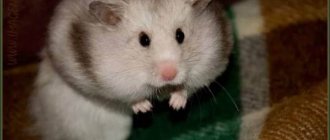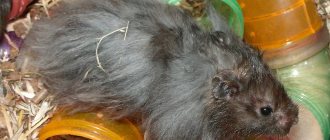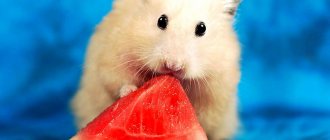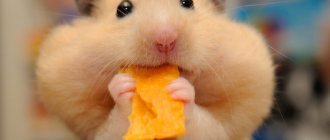| Class : Mammals | Family : Hamsters | Order : Rodents |
| Genus : Hairy-footed hamsters | Species : Djungarian hamster | |
One of the most beloved four-legged pets is Djungarian hamsters.
It's not just about their charming appearance and miniature size, which makes it possible to keep animals even in small apartments. Learning about the habits, life in the wild, what they eat, and decorating their house is extremely interesting for both adults and children. And the most important experience that a child will gain by interacting with these animals is a sense of responsibility for the living being entrusted to him.
How to weigh a hamster?
A hamster is a nimble animal that is difficult to keep in one place for a long time. If the pet is disobedient and untamed, you will have to cheat to find out the weight of the hamster. Use these short instructions to help you quickly measure your khoma without causing discomfort.
- Get your electronic scales ready. A regular kitchen scale will do. Their accuracy should be sufficient to weigh a light hamster.
- Take a container that matches the size of the animal. Without such an “accessory,” the animal can easily escape and it will not be possible to measure its “parameters.” The container will help contain the animal for at least a few minutes. You can use a regular glass or bowl. Before weighing, the tare weight should be reset to zero.
- To help your pet sit still, place a couple of sunflower seeds or another light treat in the container. This will interest the animal, and it will be calm for a while.
After you manage to measure the khoma, the result needs to be written down. This will help control weight loss or gain. Rapid weight loss indicates the presence of diseases. Weight control is also helpful when changing your diet or diet. This will ensure that your pet is eating new food and not hiding it in corners. A healthy hamster should weigh as much as is normal for an animal of its breed and age.
Article on the topic: Can hamsters swim and what are the dangers of water?
Dzungarian breed
Dzungarik is the most common inhabitant of apartments. This is a fluffy, cute pet that is fun to watch. The body shape of the jungarik is slightly different from its counterparts. The spine closer to the tail is slightly curved.
The animal is small in size, as a rule, no more than 10 cm. But the cheeks of the dwarf can grow significantly when “replenishing reserves”. While eating, hamsters are interesting and funny to watch. The size of the pet depends on the characteristics of its maintenance and nutrition. The Djungarian hamster weighs no more than 50 g.
Body
The body is oval in shape (when viewed from above), wide and short, twice the length of the head, equal in width (when viewed from above) both at the shoulders and in the croup area. The back is straight, in the croup area it bends smoothly and descends down to the tail. Body length 8-10 cm.
Minimum weight 25 grams, the larger the Djungarian hamster the better, but without signs of obesity.
| perfect | Great | very good Fine | Fine | satisfactorily | unsatisfactory |
| from 61 grams | 51-60 grams | 41-50 grams | 31-40 grams | 25-30 grams | less than 25 grams |
Flaws
Various deviations from the ideal physique. Fat or thin. Small or narrow body. Irregular back line, narrow chest. Excess skin.
Vices
Very serious deviations from the correct physique. Any deformities. Severe obesity or malnutrition.
Syrian breed
The Syrian hamster is larger than the dwarf hamster. When choosing this breed, you should remember that the animal needs more space and food. The pet reaches 19 cm in length. The Syrian is sociable. This is a tame creature that requires a lot of attention and loves to be held. The weight of a Syrian varies between 100–200 grams.
Syrian Khomas have long or short hair and a variety of colors. It is recommended to keep animals in separate, spacious cages. Make sure your pet has enough space and food.
Common hamster (wild)
The common hamster is a wild creature that is not kept at home. It is quite dangerous for humans, carries various diseases and is large in size. The size of an adult hamster is 30 cm. The creature has a weight appropriate for its size.
When choosing a pet, decide in advance on the breed of the animal. The size of the cage and equipment should be appropriate for the size of the hamster. Monitor your pet's weight to avoid health problems. A cheerful, playful Homa will delight you for a long time if you show appropriate attention and care.
Article on the topic: How to make a terrarium for a land turtle with your own hands (drawings and photos of products made by yourself at home from improvised means and materials)
Why do you need to record your hamster's weight?
There are several points that the owner needs to pay attention to in order to notice health problems in the pet in time; one of the most important indicators is the pet’s weight. Knowing the usual weight of your adult animal, you can quickly determine the following cases:
Pregnant female
Rapid weight gain begins 7-10 days after fertilization, which allows an attentive owner to monitor the successful course of pregnancy, introduce foods rich in vitamins and protein into the expectant mother’s diet in a timely manner, and increase the amount of drinking water.
Also, the owner will promptly move the animal into a separate cage with the necessary building material for the nest.
Complications during pregnancy
Knowing the initial and current weight of the female, you can find out the approximate date of birth and promptly seek help from a veterinarian if the situation requires it. For example, a decrease in the weight of a pregnant female indicates intrauterine fetal death or that childbirth occurred, but the hamster ate the babies.
Animal diseases
Weight gain and an enlarged abdomen may be a sign of digestive problems, ascites, heart disease or cancer.
Poor nutrition
A gradual weight gain in an adult, mature animal may be a signal that it is time to put your pet on a diet, otherwise obesity cannot be avoided. Reducing the amount of grains and nuts in the diet and increasing the proportion of vegetables and herbs will help avoid problems such as blockage of blood vessels, cardiac arrest and digestive problems.
In addition to nutrition, you will also have to adjust the motor mode: provide the pet with the opportunity to walk outside the cage, purchase a running wheel.
What does a hamster's weight change affect?
How much does a hamster weigh
Even a non-professional breeder can breed wonderful fluffy hamsters. Before you become the owner of this little friend, you need to decide on the breed, since this determines how much the hamster weighs.
The parameters of a pet are very important, as they affect such nuances as:
- The size of the future home.
- Accessories for the cage, such as a wheel, mazes and more.
- Amount of feed consumed.
- The presence or absence of neighbors.
Djungarian hamsters
Djungarians are one of the most famous domestic animals, and have long rightfully won their place in the hearts of furry pet lovers. Thanks to their fascinating appearance and playful behavior, watching pets is quite interesting and curious.
The body shape of the dzhungarik has some differences in comparison with its closest relatives, since in the area of the tail its spine is slightly curved, which visually creates a small hump.
The body of a Djungarian hamster grows to a maximum of 10 cm, but generally the animal has a length of 6 to 9 cm. To understand how much a Djungarian hamster weighs, you need to take into account its size. This breed averages no more than 50 grams.
Taking into account the parameters of the animal, experts recommend purchasing a cage with dimensions of 30*50 cm, with frequent twigs. The diameter of the wheel should be about 13-17 cm.
Common hamster
To answer the question of how much a common hamster weighs, you must first of all take into account its size. The animal reaches 30 cm in length, while its tail measures about 5-8 cm.
It is typical for a hamster to create certain cozy living conditions in its burrow, which has a large number of rooms and passages. There are times when in the storage rooms of this hardworking animal there are reserves of about 15 kg.
Syrian breed of hamsters
Owners should think in advance about how much a Syrian hamster weighs, since it is much larger than a dwarf hamster.
An adult furry pet can reach a size of about 19 cm and is a fairly large representative of its family. The animal loves to communicate with people and is willing to be held.
Such a pet weighs 100-200 grams. It is typical for this breed to have both long and short hair. Best for a hamster:
- Housing size 40*60 cm.
- Treadmill with a diameter of 18 cm.
- Living without neighbors.
Article on the topic: Why does the shell of the red-eared turtle darken or turn green?
Methods for determining the age of a hamster
Often sellers who do not breed these animals do not provide accurate information about the age of the hamster. Selecting a young individual is quite difficult. There are a number of indirect signs that should be taken into account. First of all, you need to weigh the animal. An animal older than 3 months weighs more than 30 g. If the rodent is too obese, this indicates its old age.
In addition, you should pay attention to your pet's behavior. The younger the animal, the more active it is. An older hamster may look lethargic and sleepy most of the time. It is imperative to examine the eyes and fur. If the rodent is covered with soft fluff and has small bald patches, it means that it is about 2 weeks old. Cloudy eyes and dull fur are the main differences between sick and old individuals.
Siberian breed of hamsters
The Siberian breed of hamster typically lives in the vast expanses of Siberia, where it can be found in its natural environment.
In appearance it is similar to the dzhungarika, and differs from them only in the color of its coat, which has a gray tint, and in winter it takes on a white color. This feature is interesting to study when animals live at home.
If owners are wondering how much a Djungarian hamster and its Siberian relative weigh, then the answer is quite simple. Since the weight of both of these representatives varies from 40 to 50 grams, Siberian hamsters grow to no more than 8 cm. For their maintenance, exactly the same conditions can be organized as for Djungarian hamsters.
Description of the breed
Djungarian hamsters are small, furry animals with a pointed muzzle and small ears. These creatures are active and inquisitive. Many people try to change their coat color, believing that such animals have better health. However, there are breeders who prefer pets of exotic colors.
Habitat
The homeland of Djungarian hamsters is the wormwood, xerophytic, gravelly-cinquefoil, and cereal-desert zones of North-Eastern Kazakhstan, Khakassia, and Western Siberia. Representatives of the breed also live in Altai. They can rarely be found in the steppe zones of the USA and Canada, but in these regions the wild population originated from pets brought from Europe, which people released into the natural environment.
Wild hamsters living in steppes and deserts are forced to obtain their own food, so their diet includes many types of food.
Rodents try to stay away from people, but when there is a lack of food in their natural environment, they raid agricultural land.
Coat color and length
Under natural conditions, the color of an animal's coat changes throughout the year. In spring and early summer, the fur on the back of the rodent is dark gray. At the same time, the abdomen remains beige. As the vegetation dies by the beginning of autumn, the fur acquires a pearl color.
In winter, the fur on the back becomes grey-white. This breed is characterized by a stripe of dark fur running along the spine and extending to the head. Changing colors helps animals protect themselves from predators. The length of the coat does not exceed 1 cm. There is a dense undercoat that protects the rodent from the cold. When kept at home, the color of the pet's fur does not change.
Color options for Djungarian hamsters.
Length and weight
Djungarians are small rodents whose body length is on average 7-15 cm. However, in the population there are smaller individuals that grow to 5-6 cm by the time of puberty.
The animal does not weigh the same throughout the year. In winter, it quickly loses weight, and in spring and summer it gains fat, even if the rodent lives in captivity and receives a sufficient amount of food every day. The weight of females is 19-36 g, and males - 19-45 g.
Character and lifestyle
In their natural environment, hamsters are nocturnal to avoid predators. Rodents dig holes or occupy others, often making nests in rock crevices. The animals spend most of the day in their shelter. Representatives of the species make provisions for the cold season.
Domesticated animals have largely retained the habits of their wild relatives. They are most active at night and can carry food into their house to stock up in case of a hungry period. These animals fiercely defend their territory. The fights between them are fierce.
The rodent is distinguished by its friendliness towards humans. The animal quickly gets used to its owner and begins to respond to its name. Loves stroking. You can accustom the animal to regular combing of its fur. Some pets fall asleep easily in your arms.
Djungarians love to be petted.
Lifespan
In their natural environment, these animals often die at a young age due to lack of food and attacks by predators. In captivity, they live on average about 2-3 years. However, if you provide the rodent with proper care, it can please its owner for 4 years.
Dwarf hamsters
Most of all, owners prefer to purchase dwarf-sized hamsters. This is due to the low amount of hassle and ease of caring for the animal.
Dwarf breeds mean individuals weighing no more than 50 grams, with a height of about 5 cm.
For pets of this size, cages of 30*50 are suitable, and a water wheel can be taken with a diameter of about 13-15 cm.
Dwarf hamster breeds:
- Campbell's hamster.
- Taylor's hamster.
- Roborovsky's hamster, which is the smallest size.
Before choosing the most suitable pet for yourself and understanding how much a hamster should weigh, you need to consider several main features. However, regardless of the breed, keeping an animal at home will certainly bring joy and positive emotions to all residents of the house, the main thing is to pay attention to it and provide proper care.
Article on the topic: The structure of the skeleton and body of hamsters, temperature and features distinctive from mice
Weight and size of hamsters of different breeds
Hamsters are wonderful animals that even a beginner can breed at home. Before you buy an animal, you need to know exactly the breed, because it depends on how much the hamster weighs. The weight and size of the pet are important. Based on the size of the pet, you should consider:
- the size of the cage you should buy;
- a set of pet entertainment (wheel, sticks) and their sizes;
- living together or living alone;
- amount of feed.
Djungarian hamster
This type of hamster has long taken root in modern apartments. His appearance is very pleasant, his behavior is funny, you can watch his actions for a long time.
The hamster differs in body shape from its relatives. On the back, closer to the tail, its spine is slightly curved, so it feels like the animal has a small hump.
It is very interesting to watch such an animal when it stuffs its cheek pouches; they are very large and can stretch well.
The size of the Djungarian hamster does not exceed 10 cm. Usually these animals grow up to 6-9 cm. Height and weight depend on the conditions of detention and individual characteristics. The weight of a Djungarian hamster can reach 50 grams.
djungarian hamster
Based on these data, experts advise buying a cage measuring 30x50 cm, with fine bars. The running wheel can be purchased with a diameter of 13-17 cm.
These hamsters can be kept alone.
Head, eyes, teeth and ears
The head is large, wide with a well-filled, blunt and relatively short muzzle, with developed jaws. The head profile is slightly curved (convex). The head is set tightly on the shoulders, with no visible neck.
The eyes of the Djungarian hamster are large, convex, rounded when viewed from the front, but slightly almond-shaped when viewed from the side, and set wide apart.
The ears are of medium size, larger than the eyes, set quite wide, vertical, rounded at the tips, without folds, when viewed from the side, the outer edge of the ear has a slight bend in the middle, the ears are not pressed to the body, clearly visible above the coat.
Flaws
Minor deviations from the correct type. Slightly small eyes, slightly deep-set, slightly irregular in shape. The ears are slightly irregular in shape, small, flattened. Narrow and/or unfilled muzzle, narrow and long head, straight head profile. Slightly damaged ears.
Vices
Absence of an ear or ears, any damage to the eyes. Very strong deviations from type. Any deformities.
Syrian hamster
If future owners have chosen the Syrian breed, they need to know how much a Syrian hamster weighs, because this species is very different in size from the Djungarian. The size of an adult Syrian hamster can reach 19 cm, which is quite a large animal.
Despite its size, this hamster loves to be held, loves to attract attention and enjoys any communication.
Article on the topic: Common viper (life expectancy, reproduction, snake venom)
The weight of the Syrian hamster ranges from 100 to 200 grams.
Syrian hamster
It is interesting that pets of this breed can be either short-haired or long-haired.
- cage 40x60 cm;
- running wheel, diameter 18 cm;
- Single accommodation.
How big do Syrian hamsters grow?
One of the popular rodent companions today is the Syrian or Central Asian hamster. This is a medium-sized animal with a stocky, thick body. Its muzzle is short, with large cheek pouches. The ears are small, covered with fur. The tail is almost invisible due to the fur. Its length is about 1.5 cm. The paws are strong and wide. There are 4 toes on the front ones, 5 on the back ones. The wool can be colored in various shades. The most common of them is golden.
If the hamster is well cared for and fed a balanced diet, it can reach a maximum length of 13–14 cm. Individual adults can grow up to 18 cm. At birth, babies have a body length of 2–3 cm.
Did you know? In their cheek pouches, hamsters are able to carry food that weighs twice as much as their body weight.
Siberian hamster
The Siberian hamster can be found in nature; it lives in Siberia, hence its name.
They are very reminiscent of Djungarian hamsters, differing only in the color of their fur. The Siberian has a gray color, and in winter the animal’s coat becomes completely white. This is especially interesting to observe when kept at home.
The average weight of a pet reaches 40-50 grams, and these animals grow no more than 8 cm in size. To keep a Siberian hamster, a cage the same as that of a Djungarian pet is suitable.
siberian hamster
Rules for caring for a hamster
Hamsters are able to independently monitor the cleanliness of their fur. It is enough to change the litter in a timely manner. You should check your ears periodically and, if necessary, carefully remove dirt. In addition, it is necessary to inspect the animal’s oral cavity 2 times a week to promptly identify overgrown teeth.
What not to do
Hamsters that live in steppe and mountainous areas are poor swimmers, so it is not recommended to bathe them with soap. This will not only be extremely stressful for the animal, but can also lead to the development of skin diseases. When cleaning the cage, it is not recommended to leave the rodent on a high surface. In nature, hamsters live on the plain, so they do not understand how dangerous falling is.
Common hamster (wild)
The weight of the common hamster is greater than all other breeds. Because of its size, it is not a frequent guest in homes; it is more convenient to keep small hamsters.
The body length of an ordinary hamster reaches 30 cm. It is a tailed animal, and the tail is quite long, from 5 to 8 cm.
common hamster
This hamster is a big fan of “home comfort”; its burrows consist of many corridors, storage rooms and exits. Sometimes in the storerooms of such a hard worker you can find reserves of up to 15 kg.
Care and maintenance at home
Proper care and comfortable conditions will ensure that the animal will always be active, friendly and cheerful.
Selecting a cage and filling it
The animal should be provided with sufficient freedom of movement. The cage must be at least 50x30 cm. A small space will lead to low physical activity, which can cause limb failure. You should not choose a high cage, because hamsters love to climb its walls. Falls from heights are very dangerous for a hamster.
Due to the high risk of injury, multi-story cages or complex staircase structures should be avoided.
Sawdust from fruit trees can be used as filler. Needles cannot be used because they cause allergies, lead to breathing problems and death.
You can buy corn litter at the pet store. It is considered the most convenient.
The cage can be filled with undyed paper napkins or towels, which should be torn into small pieces.
For a Djungarian hamster, it is necessary to install a wheel; its diameter should not be less than 16 cm. A small design will lead to curvature of the spine, which can cause limb failure.
You need to put a rest house in the cage. The animal will sleep in it during the day. It is not recommended to use houses with windows, because hamsters often get stuck in them.
Cotton wool, hay, fabric are hazardous materials. They must be kept away from the rodent.
Nutritional Features
Water for the animal is poured into a vacuum or ball drinker. The fluid should be changed daily. Bowls are not placed in the cage, as a wet animal may get sick.
The Djungarian hamster is prone to diabetes. For this reason, you should remove all sweet foods from your diet. The list of unsuitable foods includes carrots, apples, corn, raspberries, peach, pumpkin, etc. Potatoes, baked goods, onions, garlic, and citrus fruits should not be given.
The hamster's diet should consist of dry and wet food. It is recommended to purchase the first one ready-made at a pet store. It is better to use expensive feed, because... they are more balanced.
You can feed the animal with cucumber, lettuce, cauliflower or parsley. All leftover food must be removed immediately. To compensate for the lack of protein, the hamster should be given boiled chicken meat without spices. Outdoor insects should not be offered as they are infested with parasites.











